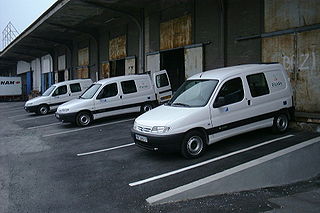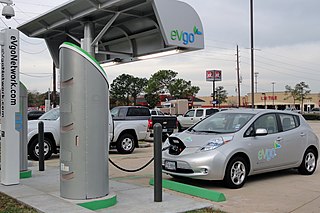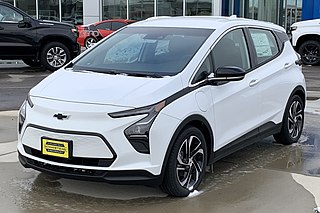Hybrid Synergy Drive (HSD), also known as Toyota Hybrid System II, is the brand name of Toyota Motor Corporation for the hybrid car drive train technology used in vehicles with the Toyota and Lexus marques. First introduced on the Prius, the technology is an option on several other Toyota and Lexus vehicles and has been adapted for the electric drive system of the hydrogen-powered Mirai, and for a plug-in hybrid version of the Prius. Previously, Toyota also licensed its HSD technology to Nissan for use in its Nissan Altima Hybrid. Its parts supplier Aisin offers similar hybrid transmissions to other car companies.

The Honda EV Plus was an experimental electric vehicle which was the first battery electric vehicle from a major automaker that did not use lead acid batteries. Roughly 340 EV Plus models were produced and released. Production of the EV Plus was discontinued in 1999 after Honda announced the release of its first hybrid electric vehicle, the Honda Insight.

The CitiCar is a car produced from 1974 to 1977 by Sebring, Florida–based Sebring-Vanguard, Inc. After being bought out by Commuter Vehicles, Inc, Sebring-Vanguard produced the similar Comuta-Car and Comuta-Van from 1979 to 1982. Similarities to its exterior design can be spotted in the Danish Kewet and the later Norwegian Buddy electric car. Accounting for all CitiCar variants, a total of 4,444 units were produced up to 1979, the most since 1945 for an electric car assembled in North America until surpassed in 2011 by the Tesla.

The Ford Ranger EV is a battery electric compact pickup truck that was produced by the Ford Motor Company and was the automaker's first all-electric production vehicle. It was produced starting in the 1998 model year through 2002 and is no longer in production. It is built upon a light truck chassis used in the Ford Explorer. Most vehicles were sold with nickel–metal hydride batteries (NiMH). A few vehicles with lead-acid batteries were sold, but most units were leased for fleet use.
MIEV (Mitsubishi In-wheel motor Electric Vehicle) or MiEV (Mitsubishi innovative Electric Vehicle) is the name given by Japanese automaker Mitsubishi Motors (MMC) to its alternative propulsion technologies. From late 2006, “MiEV” encompasses all of Mitsubishi Motors’s electric drive systems work, including lithium-ion batteries, in-wheel motors and other technologies related to electric vehicle (EV), hybrid-electric vehicle and fuel-cell vehicles.

The Citroën Berlingo électrique is a battery-powered version of the first-generation Berlingo range of vans, built and sold between 1998 and 2005. It has a 162 V Saft NiCd battery, a 28 kW Leroy Somer electric motor and has a maximum speed of 95 km/h (59 mph), with a maximum range of 95 km (59 mi) in typical driving. It replaces the C15 électrique.

Buddy is a Norwegian electric city car, produced by Buddy Electric in the early 2000s, formerly known as Pure Mobility and Elbil Norge AS, at Økern in Oslo. In 2007, the Buddy, and its predecessor, the Kewet, made up 20% of the electric cars in Norway. Since its inception in 1991, combined sales of the Kewet and Buddy had totaled about 1,500 vehicles through October 2013, of which, 1,087 were registered in Norway.

The Renault Zoe, known as Renault Zoe E-Tech Electric since 2021, is a five-door supermini electric car produced by the French manufacturer Renault. Renault originally unveiled, under the Zoe name, a number of different concept cars. Initially in 2005 as the Zoe City Car and later as the Zoe Z.E. electric concept was shown in two different versions in 2009 and 2010 under the Renault Z.E. name. A production ready version of the Zoe was shown at the 2012 Geneva Motor Show. The Renault Zoe is based on the platform of the Renault Clio.

The Tesla Model S is a battery electric executive car with a liftback body style built by Tesla, Inc. since 2012. The Model S features a battery-powered dual-motor, all-wheel drive layout, although earlier versions featured a rear-motor and rear-wheel drive layout.

The Mitsubishi i-MiEV is a five-door electric kei car produced in the 2010s by Mitsubishi Motors, and is the electric version of the Mitsubishi i. Rebadged variants of the i-MiEV are also sold by PSA as the Peugeot iOn and Citroën C-Zero, mainly in Europe. The i-MiEV was the world's first modern highway-capable mass production electric car.

A plug-in electric vehicle (PEV) is any road vehicle that can utilize an external source of electricity to store electrical energy within its onboard rechargeable battery packs, to power an electric motor and help propelling the wheels. PEV is a subset of electric vehicles, and includes all-electric/battery electric vehicles (BEVs) and plug-in hybrid electric vehicles (PHEVs). Sales of the first series production plug-in electric vehicles began in December 2008 with the introduction of the plug-in hybrid BYD F3DM, and then with the all-electric Mitsubishi i-MiEV in July 2009, but global retail sales only gained traction after the introduction of the mass production all-electric Nissan Leaf and the plug-in hybrid Chevrolet Volt in December 2010.

A range extender is a fuel-based auxiliary power unit (APU) that extends the range of a battery electric vehicle by driving an electric generator that charges the vehicle's battery. This arrangement is known as a series hybrid drivetrain. The most commonly used range extenders are internal combustion engines, but fuel-cells or other engine types can be used.

Range anxiety is the driver's fear that a vehicle has insufficient energy storage to cover the road distance needed to reach its intended destination, and would thus strand the vehicle's occupants mid-way. The term, which is now primarily used in reference to the practical driving range of battery electric vehicles (BEVs), is considered to be one of the major psychological barriers to large-scale public adoption of electric cars.

The Renault Twizy is a two-seat electric microcar designed and marketed by Renault. It is classified in Europe as either a light or heavy quadricycle depending on the output power, which is either 4 kW (5.4 hp) for the 45 model or 13 kW (17 hp) for the 80 model, both names reflecting its top speed in km/h. Originally manufactured in Valladolid, Spain, production was moved to Busan in South Korea in March 2019 to meet increased demand in Asia. In July 2023 it was announced that production of the Twizy was to end in September 2023; it is to be replaced by the new Mobilize Duo.

The Norwegian fleet of plug-in electric vehicles is the largest per capita in the world. In December 2016, Norway became the first country where five in every 100 passenger cars on the road were plug-in; attained 10% in October 2018, and reached 25% in September 2022.

The second generation Chevrolet Volt is a plug-in hybrid electric compact car produced by General Motors under the Chevrolet brand. It debuted at the 2015 North American International Auto Show to replace the original Volt, on sale since 2010. Retail deliveries as a 2016 model year began in October 2015 in the U.S. and Canada, and it was released in Mexico in December 2015. Availability of the 2016 model was limited to California and the other 10 states that follow California's zero emission vehicle regulations. It went on sale as a 2017 model year in the rest of the U.S. in February 2016. Volt production ended on February 15, 2019.

The Chevrolet Bolt EV is a battery electric subcompact hatchback produced by General Motors under the Chevrolet marque. The Bolt was produced from late 2016 to mid-2021, subsequently restarting in early 2022, until late 2023. In mid-2023, GM officials said they would cancel the car, then three months later announced plans but no date for a next-generation model.

The Kia Niro is a compact crossover SUV (C-segment) manufactured by Kia since 2016. It is an electrification-focused vehicle, offering three versions: hybrid, plug-in hybrid and battery electric variants.

The Hyundai Ioniq 5 is a battery electric compact crossover SUV produced by Hyundai since 2021. It is the first product to be marketed under the electric cars-focused Ioniq sub-brand, and the first model developed on the Hyundai Electric Global Modular Platform (E-GMP).

Hyundai E-GMP is a dedicated battery electric vehicle platform for Hyundai Motor Group automobiles. It is the first electric-only dedicated platform by Hyundai. It has been used for Hyundai, Kia, and Genesis automobiles starting in 2021. It follows Hyundai's earlier Power Electric System, which describes the drivetrain of an electric vehicle, including the traction motor, storage battery, and power electronics.


















